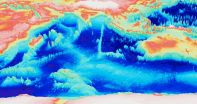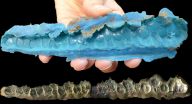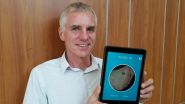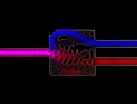Reading the Earth's LIPS
2015-05-28
(Press-News.org) Lip reading normally involves deciphering speech patterns, movements, gestures and expressions just by watching a person speak. Planet Earth has LIPS, too - they are an acronym for Large Igneous Provinces, huge accumulations of igneous rocks that form when hot magma extrudes from inside the Earth and flows onto the surface of the seafloor under several kilometres of water.
An international team of scientists including University of Sydney geophysicists Professor Dietmar Müller, Dr Simon Williams and Dr Maria Seton from the School of Geosciences have found a novel way to 'read the Earth's LIPS'. Their findings are reported in a Nature Geoscience article in which they show for the first time that LIPS have a close working relationship with underwater mountain ranges called mid-ocean ridges.
LIPS are known to form at hotspots where hot cylindrical upwellings called plumes are rising from the deep Earth's interior, intersecting the surface.
Professor Müller explains: "Conventional wisdom has it that these plumes, and their associated catastrophic LIPS, have no relationship to mid-ocean ridges where the slow divergence between tectonic plates gives rise to volcanism that steadily and continuously generates new ocean crust."
Now the research team has uncovered a previously missed connection between LIPS and mid-ocean ridges. They found that mantle plumes can anchor mid-ocean ridges over long periods of time, leading to a connection of mid-ocean ridges and hotspots that cannot easily be broken up.
This attraction of mid-ocean ridges to plumes promotes successive eruptions of LIPS near mid-ocean ridges over long time periods, resulting in a myriad of igneous extrusions on top of and next to each other.
"It is important in our understanding of LIPS in the ocean basins, as it means that not all LIPS form as giant eruptions over very short times, as was originally thought," said Dr Williams.
Unlike massive eruptions on continents, the undersea eruptions are not catastrophic and are unlikely to have caused mass extinctions and climate change. However, they are just as impressive in terms of volume.
Dr Seton adds: "It means that LIPS in the oceans are less dangerous to life on Earth, as they trickle out in many successive eruptions, not just one giant outpouring of lava, as LIPS on continents."
"The findings change our understanding of massive volcanism deep in the ocean basins", said Professor Müller. "For example, the Kerguelen Plateau in the southern Indian Ocean, is over twice as big as New South Wales, and has acquired its massive size over tens of millions of years, whereas the similarly large Siberian Flood Basalts wiped out the majority of marine and land species on Earth within just 60,000 years."
INFORMATION:
[Attachments] See images for this press release:

ELSE PRESS RELEASES FROM THIS DATE:
2015-05-28
Despite community concerns about living under high-voltage power lines, a world-first QUT study reveals that there are far more charged particles beside busy roads.
The study, published in the international journal Science of the Total Environment was conducted by Dr Rohan Jayaratne, Dr Xuan Ling and Professor Lidia Morawska from QUT's International Laboratory for Air Quality and Health who found that within 10 metres of a freeway, charged particles were up to 15 times more concentrated than beneath high-voltage power lines.
"Although the effects of ions and charged ...
2015-05-28
ESF has just published a report on a pilot study of the career paths of post-doctorates and doctorate alumni from five research funding and research performing organisations: AXA Research Fund (AXA RF), France, Fonds National de la Recherche (FNR), Luxembourg, Goethe Graduate Academy at the Goethe University Frankfurt (GRADE), Paul Scherrer Institute (PSI), Switzerland and TDR, the Special Programme for Research and Training in Tropical Diseases, a co-sponsored programme of UNICEF, UNDP, the World Bank and WHO.
The study comprised focus groups and a survey of 880 doctorate ...
2015-05-28
Earthquakes kill, but their aftershocks can cause the rapid collapse of buildings left standing in the aftermath of the initial quake. Research published in the International Journal of Reliability and Safety offers a new approach to predicting which buildings might be most susceptible to potentially devastating collapse due to the ground-shaking aftershock tremors.
Negar Nazari and John W. van de Lindt of the Department of Civil and Environmental Engineering, at Colorado State University in Fort Collins and Yue Li of Michigan Technological University, in Houghton, USA, ...
2015-05-28
In the most extensive survey of its kind ever conducted, a team of scientists have found an unambiguous link between the presence of supermassive black holes that power high-speed, radio-signal-emitting jets and the merger history of their host galaxies. Almost all of the galaxies hosting these jets were found to be merging with another galaxy, or to have done so recently. The results lend significant weight to the case for jets being the result of merging black holes and will be presented in the Astrophysical Journal.
A team of astronomers using the NASA/ESA Hubble Space ...
2015-05-28
Researchers from the University of Leicester have discovered that when it comes to rubbers, textured surfaces, and reproduction, more fluid formulations have greater reliability than those that are thick and sticky.
Rubber compounds are widely used to mould and produce copies of textured surfaces for scientific analysis, but so far little research has been done to establish which rubbers make the most reliable copies.
A new study published in the academic journal Scientific Reports, led by Professor Mark Purnell from the University of Leicester's Department of Geology, ...
2015-05-28
The fixed-dose drug combination ombitasvir/paritaprevir/ritonavir (trade name Viekirax) has been available since January 2015 for the treatment of adults with chronic hepatitis C infection. The German Institute for Quality and Efficiency in Health Care (IQWiG) examined in a dossier assessment whether this drug combination offers an added benefit over the appropriate comparator therapy.
According to the findings, there are indications of an added benefit in patients who have not yet developed cirrhosis of the liver and who are infected with the hepatitis C virus (HCV) ...
2015-05-28
This news release is available in German. FRANKFURT. Scientists at the Goethe University Frankfurt and at the Senckenberg Biodiversity and Climate Research Centre working together with their Canadian counterparts, have reconstructed the climatic development of the Arctic Ocean during the Cretaceous period, 145 to 66 million years ago. The research team comes to the conclusion that there was a severe cold snap during the geological age known for its extreme greenhouse climate. The study published in the professional journal Geology is also intended to help improve prognoses ...
2015-05-28
(Edmonton) Each year, thousands of Canadians are given the news: they have skin cancer. It is the most common form of cancer in Canada and around the world, but if detected early, survival rates are extremely high. According to Liam Rourke, it doesn't happen nearly as often as it could.
"The difficulty is that people have a really hard time detecting skin cancer melanomas early," says Rourke, an associate professor in the Faculty of Medicine & Dentistry's Department of Medicine at the University of Alberta. "One of the reasons is that it's an exceptionally difficult task ...
2015-05-28
Investigators at Stanford University have found a surprising link between creative problem-solving and heightened activity in the cerebellum, a structure located in the back of the brain and more typically thought of as the body's movement-coordination center.
In designing the study, the researchers drew inspiration from the game Pictionary.
The cerebellum, traditionally viewed as the brain's practice-makes-perfect, movement-control center, hasn't been previously recognized as critical to creativity. The new study, a collaboration between the School of Medicine and ...
2015-05-28
Stanford electrical engineer Jelena Vuckovic wants to make computers faster and more efficient by reinventing how they send data back and forth between chips, where the work is done.
In computers today, data is pushed through wires as a stream of electrons. That takes a lot of power, which helps explain why laptops get so warm.
"Several years ago, my colleague David Miller carefully analyzed power consumption in computers, and the results were striking," said Vuckovic, referring to electrical engineering Professor David Miller. "Up to 80 percent of the microprocessor ...
LAST 30 PRESS RELEASES:
[Press-News.org] Reading the Earth's LIPS





